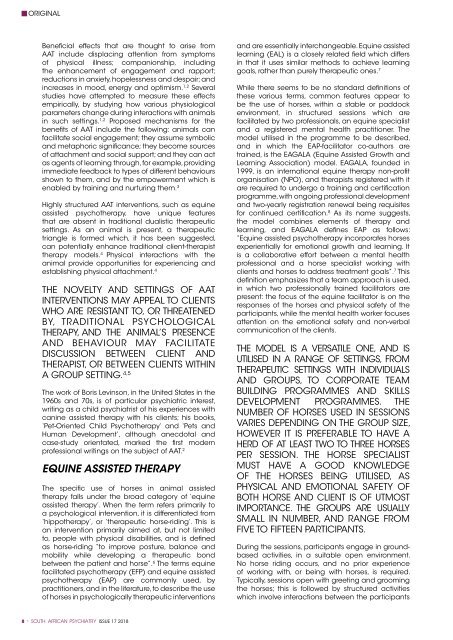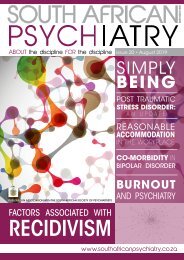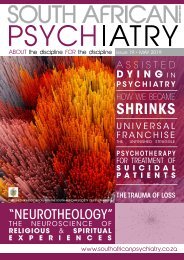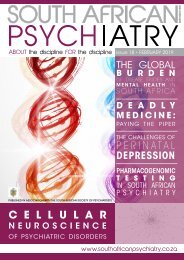South African Psychiatry - November 2018
South African Psychiatry - November 2018
South African Psychiatry - November 2018
You also want an ePaper? Increase the reach of your titles
YUMPU automatically turns print PDFs into web optimized ePapers that Google loves.
ORIGINAL<br />
Beneficial effects that are thought to arise from<br />
AAT include displacing attention from symptoms<br />
of physical illness; companionship, including<br />
the enhancement of engagement and rapport;<br />
reductions in anxiety, hopelessness and despair; and<br />
increases in mood, energy and optimism. 1,2 Several<br />
studies have attempted to measure these effects<br />
empirically, by studying how various physiological<br />
parameters change during interactions with animals<br />
in such settings. 1,2 Proposed mechanisms for the<br />
benefits of AAT include the following: animals can<br />
facilitate social engagement; they assume symbolic<br />
and metaphoric significance; they become sources<br />
of attachment and social support; and they can act<br />
as agents of learning through, for example, providing<br />
immediate feedback to types of different behaviours<br />
shown to them, and by the empowerment which is<br />
enabled by training and nurturing them. 3<br />
Highly structured AAT interventions, such as equine<br />
assisted psychotherapy, have unique features<br />
that are absent in traditional dualistic therapeutic<br />
settings. As an animal is present, a therapeutic<br />
triangle is formed which, it has been suggested,<br />
can potentially enhance traditional client-therapist<br />
therapy models. 4 Physical interactions with the<br />
animal provide opportunities for experiencing and<br />
establishing physical attachment. 4<br />
THE NOVELTY AND SETTINGS OF AAT<br />
INTERVENTIONS MAY APPEAL TO CLIENTS<br />
WHO ARE RESISTANT TO, OR THREATENED<br />
BY, TRADITIONAL PSYCHOLOGICAL<br />
THERAPY, AND THE ANIMAL’S PRESENCE<br />
AND BEHAVIOUR MAY FACILITATE<br />
DISCUSSION BETWEEN CLIENT AND<br />
THERAPIST, OR BETWEEN CLIENTS WITHIN<br />
A GROUP SETTING. 4,5<br />
The work of Boris Levinson, in the United States in the<br />
1960s and 70s, is of particular psychiatric interest,<br />
writing as a child psychiatrist of his experiences with<br />
canine assisted therapy with his clients; his books,<br />
‘Pet-Oriented Child Psychotherapy’ and ‘Pets and<br />
Human Development’, although anecdotal and<br />
case-study orientated, marked the first modern<br />
professional writings on the subject of AAT. 2<br />
EQUINE ASSISTED THERAPY<br />
The specific use of horses in animal assisted<br />
therapy falls under the broad category of ‘equine<br />
assisted therapy’. When the term refers primarily to<br />
a psychological intervention, it is differentiated from<br />
‘hippotherapy’, or ‘therapeutic horse-riding’. This is<br />
an intervention primarily aimed at, but not limited<br />
to, people with physical disabilities, and is defined<br />
as horse-riding “to improve posture, balance and<br />
mobility while developing a therapeutic bond<br />
between the patient and horse”. 6 The terms equine<br />
facilitated psychotherapy (EFP) and equine assisted<br />
psychotherapy (EAP) are commonly used, by<br />
practitioners, and in the literature, to describe the use<br />
of horses in psychologically therapeutic interventions<br />
and are essentially interchangeable. Equine assisted<br />
learning (EAL) is a closely related field which differs<br />
in that it uses similar methods to achieve learning<br />
goals, rather than purely therapeutic ones. 7<br />
While there seems to be no standard definitions of<br />
these various terms, common features appear to<br />
be the use of horses, within a stable or paddock<br />
environment, in structured sessions which are<br />
facilitated by two professionals, an equine specialist<br />
and a registered mental health practitioner. The<br />
model utilised in the programme to be described,<br />
and in which the EAP-facilitator co-authors are<br />
trained, is the EAGALA (Equine Assisted Growth and<br />
Learning Association) model. EAGALA, founded in<br />
1999, is an international equine therapy non-profit<br />
organisation (NPO), and therapists registered with it<br />
are required to undergo a training and certification<br />
programme, with ongoing professional development<br />
and two-yearly registration renewal being requisites<br />
for continued certification. 8 As its name suggests,<br />
the model combines elements of therapy and<br />
learning, and EAGALA defines EAP as follows:<br />
“Equine assisted psychotherapy incorporates horses<br />
experientially for emotional growth and learning. It<br />
is a collaborative effort between a mental health<br />
professional and a horse specialist working with<br />
clients and horses to address treatment goals”. 7 This<br />
definition emphasizes that a team approach is used,<br />
in which two professionally trained facilitators are<br />
present: the focus of the equine facilitator is on the<br />
responses of the horses and physical safety of the<br />
participants, while the mental health worker focuses<br />
attention on the emotional safety and non-verbal<br />
communication of the clients.<br />
THE MODEL IS A VERSATILE ONE, AND IS<br />
UTILISED IN A RANGE OF SETTINGS, FROM<br />
THERAPEUTIC SETTINGS WITH INDIVIDUALS<br />
AND GROUPS, TO CORPORATE TEAM<br />
BUILDING PROGRAMMES AND SKILLS<br />
DEVELOPMENT PROGRAMMES. THE<br />
NUMBER OF HORSES USED IN SESSIONS<br />
VARIES DEPENDING ON THE GROUP SIZE,<br />
HOWEVER IT IS PREFERABLE TO HAVE A<br />
HERD OF AT LEAST TWO TO THREE HORSES<br />
PER SESSION. THE HORSE SPECIALIST<br />
MUST HAVE A GOOD KNOWLEDGE<br />
OF THE HORSES BEING UTILISED, AS<br />
PHYSICAL AND EMOTIONAL SAFETY OF<br />
BOTH HORSE AND CLIENT IS OF UTMOST<br />
IMPORTANCE. THE GROUPS ARE USUALLY<br />
SMALL IN NUMBER, AND RANGE FROM<br />
FIVE TO FIFTEEN PARTICIPANTS.<br />
During the sessions, participants engage in groundbased<br />
activities, in a suitable open environment.<br />
No horse riding occurs, and no prior experience<br />
of working with, or being with horses, is required.<br />
Typically, sessions open with greeting and grooming<br />
the horses; this is followed by structured activities<br />
which involve interactions between the participants<br />
8 * SOUTH AFRICAN PSYCHIATRY ISSUE 17 <strong>2018</strong>

















